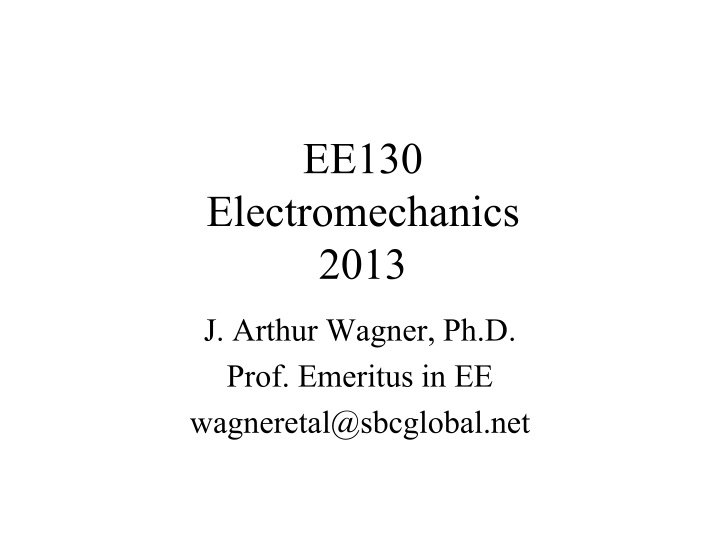
Electromechanics: Magnetic Fields, Flux, and Faraday's Law
Explore the concepts of Ampere's Law, magnetic flux density, and Faraday's Law in electromechanics. Learn about the causes of magnetic intensity, the difference between magnetic flux and flux density, and the relationship between voltage and flux. Get insights into switching voltage waveforms and harmonic comparisons in electrical engineering.
Download Presentation

Please find below an Image/Link to download the presentation.
The content on the website is provided AS IS for your information and personal use only. It may not be sold, licensed, or shared on other websites without obtaining consent from the author. If you encounter any issues during the download, it is possible that the publisher has removed the file from their server.
You are allowed to download the files provided on this website for personal or commercial use, subject to the condition that they are used lawfully. All files are the property of their respective owners.
The content on the website is provided AS IS for your information and personal use only. It may not be sold, licensed, or shared on other websites without obtaining consent from the author.
E N D
Presentation Transcript
EE130 Electromechanics 2013 J. Arthur Wagner, Ph.D. Prof. Emeritus in EE wagneretal@sbcglobal.net
Fig. 5.1 Magnetic field: Amperes Law Right hand rule Ampere s Law dl = H d i H 3i 1i closed path 2i Magnetic intensity H is a line density of magnetic field caused by current.
Question State Ampere s Law What causes magnetic intensity?
Magnetic Flux Density Magnetic Flux is an amount of magnetic field, webers [Wb]. Magnetic Flux density is an area density of magnetic flux. Something like pressure, which is an area density of force. 2 2 / [ / ] or [ ] Weber meter Wb m Tesla T
Question What is the difference between magnetic flux and magnetic flux density?
Faradays Law Flux is caused by voltage, or voltage is caused by change of flux.
Fig. 5.8 Signs for Faradays Law ( ) t right hand rule for current and flux. Load designation, i.e. the current goes in where the voltage e is positive. ( ) i t + ( ) e t N
Homework Chapter 5, Due Tuesday, Sep. 24. No Classes next Tuesday and Thursday. These days will be made up TBD. Problems 5.1, 5.2, 5.3, 5.4, 5.9 Read Chapter 5 (even though we don t show all of it in class)
Fig. 4.14 Switching voltage waveforms Check qa, vaN, qb, vbN during Ts/2. Discuss how vo is formed from vaN and vbN. What is the ON time for vo? Compare the first harmonic of vo with the first harmonic of vaN.
Voltage vaN Pk-Pk = duty cycle = period = freq =
Voltages vaN and vbN Pk-Pk = duty cycle = period = freq =
vaN, vbN, and vo = vaN - vbN Pk-Pk = duty cycle = period = freq =
vaN, vbN, and vo = vaN - vbN sign of vo bar = direction of current io =
vo Pulses are missing due to the display sample rate. What is happening to the current io bar?
Permeability, relative permeability, and permeability of air Flux density is linear with magnetic intensity in air, and most other materials that we see around us. Permeability is the proportionality constant. = B H o henries m 7 = 4 10 o The exception are materials with iron, Fe, cobalt, Co, nickel, Ni, and molybdenum (not so important).
Relative Permeability When people say, permeability , they usually mean relative permeability .
Question Calculate the permeability when the relative permeability is 250.
Fig. 5.3 B-H characteristics We have said, Current causes magnetic intensity and voltage causes flux . What ties these magnetic terms together? Answer: the material. No magnetic material is linear, only approximately. A B-H hysteresis loop is always present. Think of Hm as exciting the material below. B m B m B o sat m o H H m m
Fig. 5.4 Toroid with flux A m m i How can we state the flux density in terms of N m
Fig. 5.5 Magnetic Structure with Air Gap All motors have an air gap. Why? current flux magnetic material air gap length
